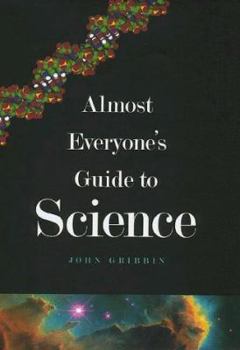Almost Everyone's Guide to Science: The Universe, Life and Everything
Select Format
Select Condition 
Book Overview
This fascinating book is a guide for the perplexed--those who are interested in science but are scared off by the technical detail. John Gribbin, an award-winning writer, now stands back from the... This description may be from another edition of this product.
Format:Hardcover
Language:English
ISBN:0300081014
ISBN13:9780300081015
Release Date:September 1999
Publisher:Yale University Press
Length:232 Pages
Weight:1.20 lbs.
Dimensions:0.9" x 6.4" x 9.5"
Customer Reviews
5 ratings
Comprehensive and accessible guide to contemporary science
Published by Thriftbooks.com User , 16 years ago
John Gribbin quotes Einstein at one point, saying "the eternal mystery of the world is its comprehnsibility . . . the fact that it is comprehensible is a miracle." Too few of us take the time to look at the world and the universe around us and simply gasp in amazement. It all works. Not only are you an amazing work but so is everything else. John Gribbin sets out to explain everything: atoms, molecules, living things, rocks, dirt, stars and more. And he does a pretty good job of it. As he states in his introduction, he takes you from the world of the very, very small to and then into the Universe. Along the way he covers life in general, DNA, evolution, stars, planets and lots more. For the dedicated reader, Gribbin makes science accessible and comprehensible. On occasion, you may have to reread a paragraph or even an entire section, but Gribbin never goes beyond a layperson's capability even when explaining the most complex subjects. Jerry
Almost Everyone's Guide to Science: The Universe, Life and Everything
Published by Thriftbooks.com User , 17 years ago
Excellant book, ties the atom to physics, chemistry, life and astronomy. Simplifies science.
Great Book
Published by Thriftbooks.com User , 22 years ago
I really enjoyed reading this book. Especially the end where it discusses planets, space, and how everything came together. It's amazing how much we puny humans can figure out about a star half way across the galaxy.The one thing that held this book back from getting a perfect 5/5, is the fact that it had _no_ pictures to help explain the concepts. This was very annoying, but it does force the reader to visualize concepts in his/her head.Over all, I would recommend this book to "Almost Everyone" interested in science.
Book Review No. 32
Published by Thriftbooks.com User , 24 years ago
This is a best-seller by an eminent scientist who doesn't believe the world is goverened by magic or the supernatural.He presents scientific evidence that everything is coherent and fits together. Gribbin starts with the smallest particle and goes to the birth of the universe including the origin of our species. This is an ambitious, never-tried-before book. It is breathtaking in scope.Don't bother to read it if you don't have a healthy curiosity or the patience to put up with complicated scientific concepts. And don't worry about not understanding all of it; what you do understand will stagger you.Interesting ideas: People are the most complex systems in the known universe. No two are exactly alike. Studies confirm tha tNinety-eight per cent of the DNA in human beings, gorillas and chimpanzees is the same...the differences tha tmake us uniquely human amount to a little over one per cent. We are one per cent human and roughly 99 per cent ape.If our planet were the size of a basketball, the thickness of the breathable atmosphere would be no more than one quarter of a millimeter, a barely noticeable 6-mile-high smear over the surface of the ball. The Earth is a ball of rock covered by a thin smear of atmosphere and ocean.In about ten billion years the Sun will cool into a solid lump. About 440 billion years ago there was a massive extinction of life on earth. Stray pieces of cosmic debris still collide with planets and one impact contributed to the death of dinosaurs about 65 million years ago.Fine-particle scientists predict the existence of different kinds of particles from anything we have seen yet. They have not been detected, but have been given names such as photonios. This class of objects is referred to as Weakly Interacting Massive Particles or WIMPs because they have mass, but don't interact very strongly with everyday matter.Astronometers and Particle Scientists would like to detect these mysterious particles directly and this may happen within the next few years. Models suggest we are swimming in a sea of WIMPs, possibly a plausible explanation of the so-called spirit world.This work is a monumental job of setting down that which, in scientific circles, is called the "Theory of Everything" (TOE) for all to understand. Gribbin has summed up the last 400 years of scientific thinking on where we came from, and where we are going, if that is of interest to you.Jim Grubb grubb@uswest.net
A Fun Read--Yes, believe it!
Published by Thriftbooks.com User , 24 years ago
Science books are generally drab, inpenetrable, and long. Gribbins' book is none of these. I found the book quite readable. The most complex scientific concepts are described in sufficient detail to tell the story, yet with clarity. He avoids math, chemical formulae, and jargon.Many scientific overview books, particularly those with sweeping titles such as this, are lengthy to the point of being imposing. At 220 pp, this is an easy read over a few days.If you're interested in understanding science from strings at 10E-35 meters to the size/age of the universe, you'll enjoy this book. As a chemist, it was illuminating to get a perspective on the other disciplines and scales of our universe.





